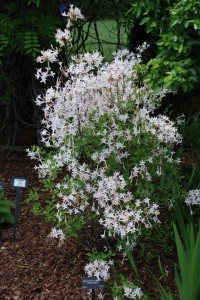Coastal Azalea (Rhododendron atlanticum) is a deciduous native azalea that grows along coastal plains of the Mid-Atlantic and Southeast U. S. Their white 1 to 1 ½ inch tubular flowers appear about the time that lilac petals are beginning to fading. Flowers are snowy white with a pinkish blush, and emit a distinctly clove fragrance. Blooms open a few days before the new spring foliage.
Coastal azalea forms a low compact deciduous shrub. It rarely grows taller than 4 feet in height and 4 to 6 feet wide. It should be grown in full sun (in zone 5b -6) and in partial shade (zones 7-8). Coastal azalea grows best in a well- drained acidic soil. It should be watered during prolonged summer dry spells. Its bluish-green foliage remains disease and pest free if plants are not environmentally stressed.
Coastal azaleas are highly stoloniferous, spreading by underground stems and forming small plant colonies around themselves. They tend to sucker a lot less in clay soils. The cultivar R. atlanticum ‘Winterthur’ has an outstanding compact growth habit and tends not to sucker.
R. atlanticum is parent to a number of hybrid deciduous azaleas:
‘Fragrant Star’ (R. canescens x R. atlanticum) – fragrant white flowers (slightly larger than ‘Snowbird’); 4 by 4 foot compact shrub with blue green foliage, introduced by Briggs Nursery in Olympia, WA.
‘Snowbird’ (R. atlanticum x R. canescens) – 4 by 4 foot compact shrub with blue green, mildew resistant foliage; introduced by Biltmore Estates in Asheville, NC.
‘Marydel’ (R. atlanticum x R. periclymenoides)- abundant pinkish-white, fragrant flowers from late April into May; introduced by the late Polly Hill.
‘My Mary’ [R. atlanticum x R. periclymenoides] x R. austrinum – very fragrant yellow flowers in late April.


 Posted in
Posted in 
